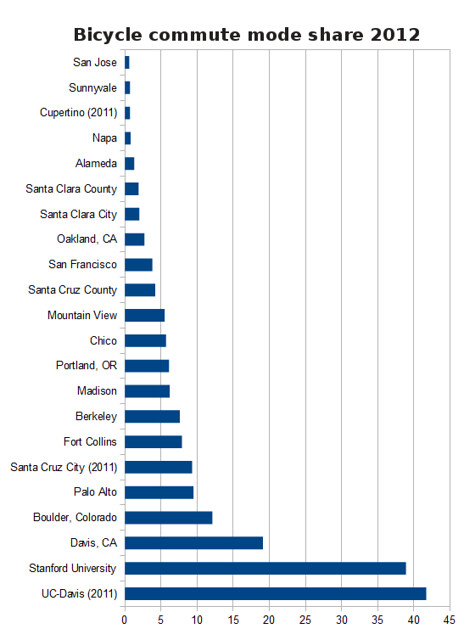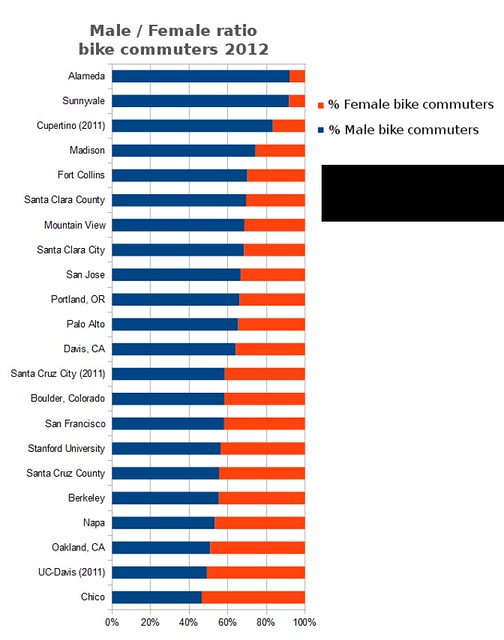Last year, we looked at bike commute numbers for San Francisco Bay Area cities as estimated by the US Census American Community Survey. The numbers for 2012 are now out, so let’s see how these cities fared.

The U.S. Census surveys 3 million Americans each year to compile statistics for the annual American Community Survey (ACS). Unlike the decennial survey, the ACS drills a little deeper into commute modes and includes those who ride bicycles in their statistics. The U.S. Census Bureau compiles yearly estimates for all states, as well as for cities, counties, metropolitan areas, and population groups of 65,000 people or more. Reports are generated every three to five years for places with less than 65,000 people (e.g. universities and small cities and towns).
Note that workers who fill out the ACS questionnaire are instructed to pick the single mode of transportation that you travel the farthest. Hence, the 5,000 people who bring their bikes on Caltrain everyday in the Bay Area don’t count as bike commuters. Ditto the thousands like me who bring their bikes on the various buses throughout the Bay Area.
I’ve grabbed 2012 bike commute data for a number of Bay Area communities. You’ll see I’ve also included other communities, including some top-ranked Bicycle Friendly Communities, for comparison. I use 2011 data for a handful of nearby communities (city of Santa Cruz, Cupertino, and University of California – Davis) because they have a population less than 65,000.

These bars represent the percentage of people who get to work by bike. In San Jose, Sunnyvale, Cupertino and Napa, we see fewer than one percent of workers get to their jobs by bike. An astounding 42% of UC-Davis students who live on campus and have a job ride their bikes to work. In the Bay Area, 38.9% of workers who live on the Stanford campus bike to work, while 9.5% of Palo Alto residents, 7.8% of Berkeley residents and 5.5% of Mountain View residents commute by bike.
Last year, I predicted a large decrease for Palo Alto and Mountain View since Facebook moved from California Avenue near downtown Palo Alto to a bike unfriendly campus near the Bay. I’m pleased to see the mode share a modest half point drop for both cities in spite of Facebook’s move.
The city of Berkeley dropped over a point to 7.6% in 2012 from 8.8% in 2011. San Francisco increased from 3.4% to 3.8%.
What about women on bikes?
The city of Philadelphia charted the male / female ratio of bike commuters for the ten most populous cities in America. Among those top 10, Philly comes out on top with females comprising 34% of bike commuters. I charted the male / female ratio of my set of cities.

Women bike commuters outnumber the men in the city of Chico, California and at the University of California – Davis. Other cities with a relatively high ratio of women to men include Oakland, Napa, Berkeley and San Francisco. The bike mecca of Portland, OR seems to be at about the middle of the pack with a 2-to-1 ratio of men to women, matching the performance of cities like “Man” Jose and Mountain View.
Very few women bike in the cities of Sunnyvale and Cupertino, which are home to male-dominated technology companies and also have low absolute bike commute rates of 0.7%. Culture may be a factor in those cities; Cupertino is majority Asian, while Asians are the second largest minority group in Sunnyvale after Caucasians. In both cities, male workers outnumber female workers by about two to one.
Half of one percent of Asians in both Cupertino and Sunnyvale ride their bikes to work, which is the same percentage seen statewide and nationwide for Asians. Among top-ranked Bicycle Friendly States, 0.04% of Asians in Washington bike to work, 1% of Colorado Asians bike to work, and 2% of Asians in Oregon bike to work. Just for grins, I also looked at middle of the road Texas (#22 among bike friendly states), where a paltry 0.02% of Asians ride a bike to work.
I’ve copied the bike share data for 2012 to Google docs if you’d like to dig into this with a little more detail. If you copy that spreadsheet and add your own cities, please feel free to link to the doc in the comments below.
Very interesting, thanks! Looking forward to more analysis.
Yes, interesting. I’ve been noticing that in my neck of Oakland (North Oakland) women are actually the clear majority of bike riders. My guess is that there is some connection between the gentrifying/hip neighborhoods and the threat of crime/violence that combines to encourage more female riding – i.e., it’s much safer than walking to/from BART, etc. Philly is a similar situation (and both are flat urban areas with a great street grid).